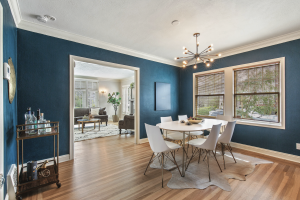
Here’s a question for you:
You’re finally ready to get started on your home search, your broker has lined up a load of viewings for you and on that very first Sunday of open houses you find THE ONE.
Do you pull the trigger?
End your (very short) home search and make an offer? Or are you convinced that you can’t possibly have found a home on day one, that going for this property is bound to mean you’re missing out on the home that’s really for you and that you would be CRAZY to let up your search now? If you’ve found this place so quickly, it stands to reason that an even better property is out there, just waiting for you to find it. Right?
Well, not necessarily. If you’re leaning more toward continuing your search despite loving the place you’ve found, you may be suffering from a case of real estate FOMO, which could actually sabotage your chances of landing a home that’s as close to perfect as you’re likely to see.
Making a decision on a home isn’t easy and doesn’t come without a liberal case of butterflies in your stomach, but fear of missing out on something better can really lead to missing out in general.
So how can this be avoided? Three words: Trust. Your. Gut.
Here are 3 ways you can gut check your potential purchase to either dispel any FOMO you might have or feel confident enough to move on and continue your search.
1. Pretend You Already Live There.
My clients often give me an “are you serious?” look when I suggest this, but it’s a really good decision-making exercise when you’re trying to make up your mind.
All you have to do is stop ‘viewing’ the property and start pretending to live in it. For instance, start in the master bedroom with the door closed, open the door, walk along the hallway or down the stairs to the living room or kitchen, imagining it’s morning, you’ve just woken up and you’re going to the kitchen to make coffee. Or maybe try sitting on the sofa in the living room and gazing out of the window or at the fireplace imagining yourself relaxing on a cozy Sunday evening as it snows outside.
Are you feeling anything yet?
How about sitting at the dining table, and imagining holding a dinner party for your friends or serving Thanksgiving dinner to your family?
How about now? Are you feeling content? Excited? Emotional? Happy? Can you see yourself making a life here? Your gut will tell you. You just have to listen.
2. Stop Pausing For Perfection.
“But it’s not perfect!”, I hear you cry! We’d still have to replace that floor. Paint that wall.

Change that vanity or move that shower stall!
Ah… so you’re looking for perfect. Ok, good luck with that.
Here’s the newsflash: it’s never going to be perfect. No property is when you’re searching for a home. 80% perfect is good. 85% is better. 90% is pretty much a property unicorn and 100% just doesn’t exist, so looking for it will be a total time suck and might ultimately drive you crazy!
But here’s the good news. That extra 10-20% is the good stuff. It’s the perfection gap that you get to fill to make the place your own. To put your personal stamp on it and make it as damn near perfect for you as you can get it. Plus, everyone likes a bit of a home project when they move into a new place – how do you think the likes of IKEA, Home Depot and Lowes stay in business? Whether it’s putting in that new bathroom you’ve already designed on a Pinterest board or refinishing a neglected hardwood floor to its former glory, this is the stuff that makes a home your own and begins your story within it.
3. Listen To Your Real Estate Agent.
If you’re working with a real estate agent worth their salt, they’ll be checking their own gut too and if they’re noticing any red flags that you may not have, now’s the time for them to point them out to you.
Although it’s no fun being a party pooper, I’ve been the voice of reason to many an excited client, pointing out potential problems with a roof, windows that need replacing, dated mechanicals, or dodgy building financials. That’s my job. To make sure my client is walking into a transaction with their eyes wide open and a complete understanding of what they might be letting themselves in for.
Your agent will also be able to advise you on the area (if it’s new to you), the sales price (if it’s over or underpriced), and how this property stacks up against comparable ones they’re aware of that you may not be. Plus, if they know there’s better on the market, or, through their broker network is aware of a better listing coming up, they can caution you to wait and see. And remember, they’re there to help you sense check what you’re thinking, to answer questions, help you see the big picture and work out whether the home you’re considering really is as great as you think it just might be.
So! Don’t count a property out just because you’ve seen it early on in your search, particularly as while mortgage rates remain so low, anything that is speaking to you is likely speaking to others and may be snapped up if you take too much of a pause.
And take it from me, it really is possible to find that dream home right at the start of your search. I’ve done it myself.
Twice.








